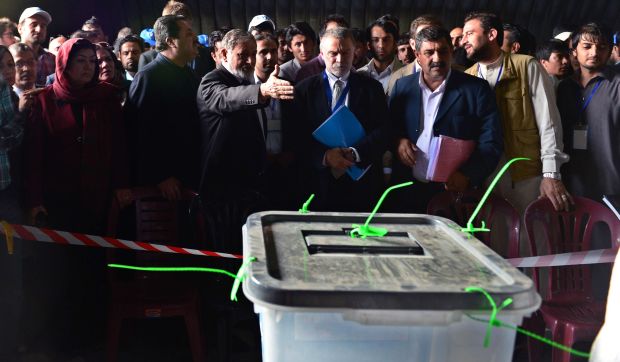By refusing to ride the tiger of demagoguery, Afghan presidential rivals Ashraf Ghani and Abdullah Abdullah have demonstrated a welcome degree of statesmanship. Rather than pushing their country towards conflict—perhaps even civil war—the two men have agreed to sort out their differences over the results of the presidential election through negotiations within the framework of existing laws.
They face a tremendous challenge. But, as often in politics, a challenge is also an opportunity. If they put that opportunity to good use, Afghanistan could emerge more united and stronger. If they fail, the vicious circle that started with the overthrow of Mohammed Zahir Shah, the last king of Afghanistan, in 1973 could continue with greater intensity.
The first thing the two leaders need to do is steer clear of the clichés that dominate the study of Afghan politics in international circles.
One such cliché is that Afghanistan is not a nation, but rather a collection of tribes and ethnic factions. That cliché is one of those facts that obscure the truth. There are at least 18 ethnic or religious communities in Afghanistan and four major linguistic groups. When looking at each other, these ethnic-cum-linguistic-cum-religious groups are conscious of their differences. However, when viewed by others, they all feel they belong to the same Afghan family.
There are no secessionist movements in Afghanistan, and no Afghan feels part of a larger—often mythical—entity beyond the borders of his country. Some Afghans harbor irredentist ambitions against Pakistan’s frontier lands, where ethnic Pashtuns and kindred tribes form a majority. However, no Afghan wants to join them. The hope is that they would join Afghanistan.
Nor do ethnic Tajiks dream of joining neighboring Tajikistan, although some might hope that Tajikistan will one day become part of a Greater Afghanistan. The same is true of Afghan Uzbeks and Turkman (Char-Imaq): they regard themselves as Afghans from start to finish.
I also know of no Hazara—Afghans of Mongol origin and Shi’ite faith—who fantasize about Mongolia as their ancestral home.
In Afghanistan, ethnic and religious communities are like different streams flowing into a single river. Here, we have a clear case of unity in diversity. All that, however, does not mean that ethnic and sectarian identities do not matter. They do. Afghans wish to see their diversity reflected in all aspects of their unity. That cannot be achieved through a system of quotas, as the West developed with its “politically correct” schemes. The most successful Afghan kings understood that by instinct—and they formed administrations that reflected the nation’s diversity without recourse to quotas based on statistical data.
The second cliché is that Afghans need to be ruled with the proverbial iron fist. Nothing could be further from the truth. In 1970, when I first visited Afghanistan, the country was perhaps the safest in the world, despite the fact that in 90 percent of the land the king and his government had little more than a symbolic presence. A decade later, despite the presence of more than 100,000 Soviet troops and local Communist militias of almost half a million men, no one was safe, even in the presidential palace in Kabul. In fact, Afghans are allergic to the iron fist. If you wish to rule them in peace, remember they prefer kid gloves.
Yet another cliché is that Afghans are mostly tribes and clans roaming in deserts and mountains or eking an existence in tiny villages. That was hardly ever the case and is less so today. Afghanistan was always organized around one or more major urban areas that, at times, even served as capitals of large empires. Ghazni, for example, was capital of one of the greatest Muslim empires under the Turkic Sultan Mahmoud. Cities such as Balkh and Herat were important centers of Islamic–Iranic culture, science and literature.
Today, with more than 25 percent of the population living in towns and cities, Afghanistan is being urbanized at a rate of 4.2 percent a year, almost twice the average annual birth rate. The emerging urban population shares with its counterparts in other parts of the world aspirations for development and democratization.
One more touch could be added to that overall picture.
During the past four decades—that is to say, since the fall of Zahir Shah—at least a third of Afghanistan’s population has experienced exile for varying lengths of time. Many have gone as far away as Western Europe, North America and Australia. Though many have not chosen to return to Afghanistan to settle, most have maintained their links. That cosmopolitan experience has fostered an interesting mix of parochialism and cosmopolitanism.
Having set aside the clichés, it would not be hard to understand that the current Afghan constitution, largely dictated by American “experts” with little or no knowledge of Afghanistan, does not reflect the realities of Afghan existence as a modernizing nation-state. The American idea of a presidential system, in which one man represents the executive power, has revealed its limitations within the United States itself. If the US manages to float within that system, it is thanks to strong institutions developed over two centuries. Lacking those institutions, which need time to develop, Afghanistan cannot be governed by a presidential system.
Thus, what Abdullah and Ghani need to do is agree on a major constitutional reform to replace the US-style presidential system with one of parliamentary government modeled on Western European democracies. Such a system would provide for the formation of coalition governments that reflected the Afghan nation’s unity without unanimity.
Constitutional reform is also needed to move away from the highly centralized system imposed on paper since the fall of the Taliban. Afghanistan would benefit from a strong dose of devolution reflecting the diversity of its communities, short of a fully federal structure.
A Ghani–Abdullah tandem, formed for a transitional period of constitutional reform and fresh local and national elections, could move the nation away from civil discord by providing a joint program around which national consensus could be built.
